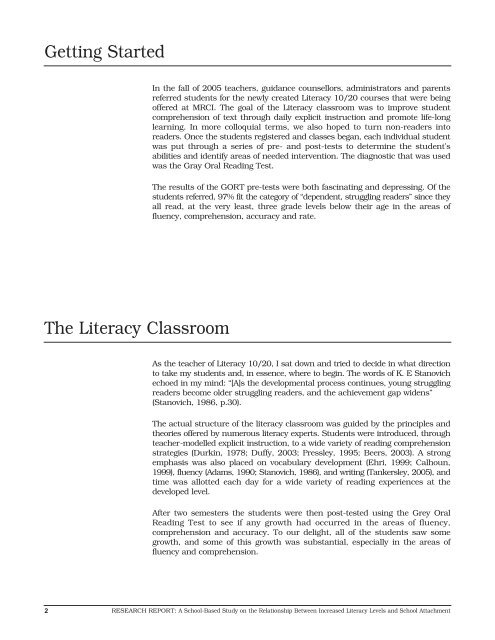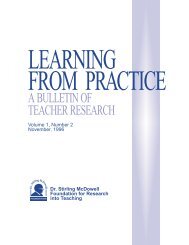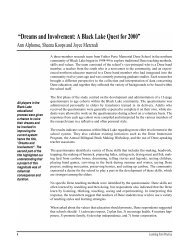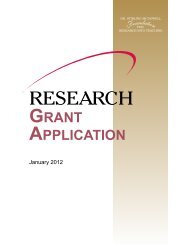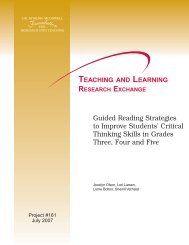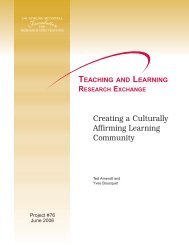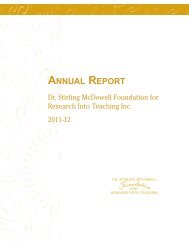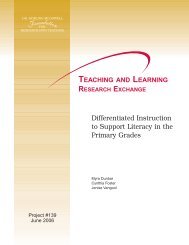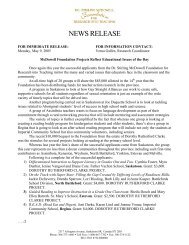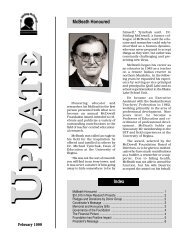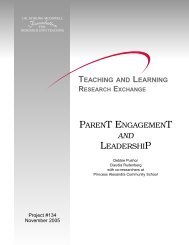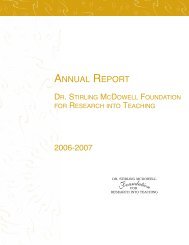Report - Dr. Stirling McDowell Foundation for Research Into Teaching
Report - Dr. Stirling McDowell Foundation for Research Into Teaching
Report - Dr. Stirling McDowell Foundation for Research Into Teaching
Create successful ePaper yourself
Turn your PDF publications into a flip-book with our unique Google optimized e-Paper software.
Getting Started<br />
In the fall of 2005 teachers, guidance counsellors, administrators and parents<br />
referred students <strong>for</strong> the newly created Literacy 10/20 courses that were being<br />
offered at MRCI. The goal of the Literacy classroom was to improve student<br />
comprehension of text through daily explicit instruction and promote life-long<br />
learning. In more colloquial terms, we also hoped to turn non-readers into<br />
readers. Once the students registered and classes began, each individual student<br />
was put through a series of pre- and post-tests to determine the student’s<br />
abilities and identify areas of needed intervention. The diagnostic that was used<br />
was the Gray Oral Reading Test.<br />
The results of the GORT pre-tests were both fascinating and depressing. Of the<br />
students referred, 97% fit the category of “dependent, struggling readers” since they<br />
all read, at the very least, three grade levels below their age in the areas of<br />
fluency, comprehension, accuracy and rate.<br />
The Literacy Classroom<br />
As the teacher of Literacy 10/20, I sat down and tried to decide in what direction<br />
to take my students and, in essence, where to begin. The words of K. E Stanovich<br />
echoed in my mind: “[A]s the developmental process continues, young struggling<br />
readers become older struggling readers, and the achievement gap widens”<br />
(Stanovich, 1986, p.30).<br />
The actual structure of the literacy classroom was guided by the principles and<br />
theories offered by numerous literacy experts. Students were introduced, through<br />
teacher-modelled explicit instruction, to a wide variety of reading comprehension<br />
strategies (Durkin, 1978; Duffy, 2003; Pressley, 1995; Beers, 2003). A strong<br />
emphasis was also placed on vocabulary development (Ehri, 1999; Calhoun,<br />
1999), fluency (Adams, 1990; Stanovich, 1986), and writing (Tankersley, 2005), and<br />
time was allotted each day <strong>for</strong> a wide variety of reading experiences at the<br />
developed level.<br />
After two semesters the students were then post-tested using the Grey Oral<br />
Reading Test to see if any growth had occurred in the areas of fluency,<br />
comprehension and accuracy. To our delight, all of the students saw some<br />
growth, and some of this growth was substantial, especially in the areas of<br />
fluency and comprehension.<br />
2 RESEARCH REPORT: A School-Based Study on the Relationship Between Increased Literacy Levels and School Attachment


